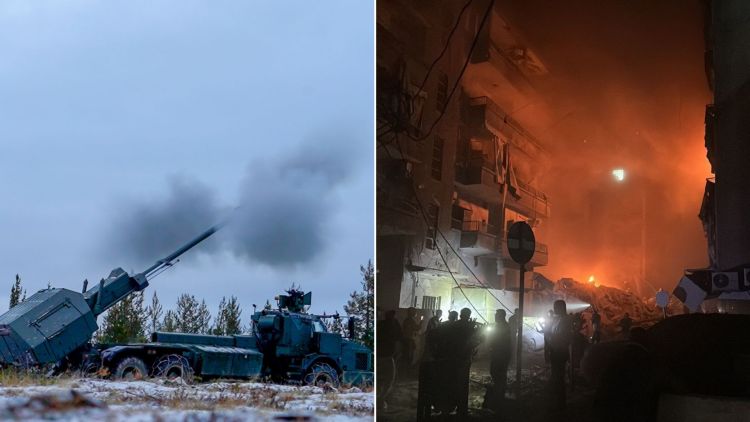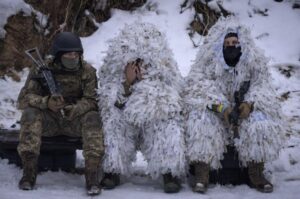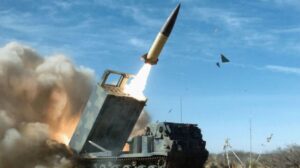Morning! Let’s dive into a quick Saturday roundup on the top defense and global affairs for November 23.
Ukraine Calls for Strong Response to Russia’s Nuclear-Capable Missile
Ukrainian President Volodymyr Zelenskyy urged world leaders on Friday to take decisive action after Russia tested its experimental “Oreshnik” nuclear-capable hypersonic missile on the Ukrainian city of Dnipro.
In a social media address, Zelenskyy stressed the need for strength, not just words, to counter Russia’s latest escalation and called on Western allies to provide updated air defense systems capable of countering such threats.
Russia claims the missile is unstoppable and unmatched globally, further intensifying the conflict after Ukraine recently used Western-supplied missiles to strike Russian territory.
Zelenskyy criticized Russia’s ally, China, for urging restraint instead of condemning Moscow’s actions, calling it a “mockery” of calls for peace.
As tensions rise, Zelenskyy emphasized that Putin must face real consequences to deter further aggression.
Meanwhile, Moscow has warned that NATO’s involvement in arming Ukraine makes allied countries potential targets.
Both sides appear to be racing for an advantage ahead of Donald Trump’s upcoming inauguration, with Trump pledging a quick peace deal but remaining critical of US aid to Ukraine.
Iran Activates ‘New, Advanced Centrifuges’ After Watchdog Censure
Iran stated Friday that it intends to activate new and advanced centrifuges in response to a decision by the International Atomic Energy Agency (IAEA) that criticizes Tehran for insufficient cooperation.
The resolution, backed by Western nations but opposed by China and Russia, demands Iran fulfill its obligations under the Non-Proliferation Treaty (NPT) and explain the presence of uranium particles at undeclared sites.
Iran maintains the measures are reversible if negotiations are reopened or Western actions are withdrawn.
Tensions around Iran’s nuclear program remain high, with critics fearing the country aims to develop nuclear weapons, a claim Tehran denies.
While Iran recently agreed to limit its stockpile of uranium enriched to near weapons-grade levels, it continues to scale back cooperation with the IAEA and warns it may withdraw from the NPT if further actions, like the reimposition of sanctions, occur.
This standoff stems from the 2018 US withdrawal from the 2015 nuclear deal, which had eased sanctions in exchange for curbs on Iran’s nuclear activities.
Iran has since increased uranium enrichment to levels near the threshold for weapons-grade material and restricted international monitoring of its program.
Israeli Airstrikes Hit Beirut, Death Toll Climbs
Israeli airstrikes on central Beirut early Saturday killed at least 11 people and injured dozens, marking the fourth attack on the Lebanese capital in less than a week.
According to The Associated Press, a building was reduced to rubble, and rescuers are still searching for survivors.
In a separate strike in Tyre, a drone killed one person and injured another, both reportedly young fishermen.
Israel has intensified operations targeting Hezbollah strongholds in Beirut’s southern suburbs, warning residents to evacuate areas near suspected facilities.
Meanwhile, Gaza remains devastated by continued Israeli bombardment, with over 44,000 killed in the 13-month war.
Strikes in Khan Younis killed six people, including children, as living conditions worsened for Gaza’s displaced population.
Severe food shortages have led to long bread lines, and two women were fatally shot while waiting for bread in Deir al-Balah.
The conflict shows no signs of resolution, with US diplomats working to broker a cease-fire amid mounting humanitarian crises.
Pakistan Imposes Curfew After Deadly Sectarian Violence
The death toll from two recent attacks on Shiite Muslim convoys in northwest Pakistan has climbed to 43, including women and children, with several others critically injured.
The ambushes, which occurred in the conflict-prone Kurram district near the Afghan border, are the latest in a series of sectarian clashes between Sunni and Shiite Muslim tribes.
Authorities have imposed a curfew, suspended mobile services, and closed the district’s main roads and markets as tensions remain high.
Local leaders have convened a jirga (tribal council) to negotiate peace, a method that previously ended deadly clashes in the region.
Human rights groups and officials have criticized the government for failing to protect citizens, calling for decisive action to end the cycle of violence.
British Army Tests Archer Howitzer in NATO Artillery Drills
The British Army successfully fired its Archer mobile howitzer for the first time during NATO’s Exercise Dynamic Front 25 in Finland.
This Swedish-made, self-propelled artillery system can fire eight rounds per minute with a range of 50 kilometers (31 miles), making it a standout in NATO’s largest-ever artillery exercise.
Alongside the Archer, troops demonstrated the Taipan radar system and the UK’s Multiple Launch Rocket System, showcasing cutting-edge firepower and interoperability among NATO allies.
The 12-day exercise began on November 14 and was held near Finland’s border with Russia, involving 5,000 soldiers from 28 countries. This exercise has underscored NATO’s growing focus on its eastern flank.
Finland’s role as host marks its first major NATO exercise since joining the alliance in 2023.
Despite freezing temperatures, troops trained for harsh Arctic conditions, preparing for what could be a challenging winter phase of the Ukraine war.
The event featured over 130 weapons, including the Finnish K9 Thunder and French Caesar howitzers, and emphasized unity and readiness among NATO members.
While some view these drills as a signal to Russia, NATO officials stress that the exercises are not meant as provocations.
New Zealand Replaces Aging Army Fleet with Urovesa Vehicles
Spain’s Urovesa recently landed a contract to supply the New Zealand Army with replacements for its decades-old Unimog and Pinzgauer vehicles.
The deal includes 20 VAMTAC (shortened for Vehículo de Alta Movilidad Táctico) ST5 light utility vehicles and 40 VAMTAC CK3 medium utility vehicles, set to modernize 25 percent of the army’s utility fleet.
The NZD 100 million ($58.4 million) investment also covers spare parts, support equipment, and advanced communication systems, with deliveries starting in 2027.
The new vehicles will support New Zealand’s military in local and international operations, as well as disaster relief.

The VAMTAC ST5 boasts a payload of 1,700 kilograms (3,740 pounds) and a top speed of 68 mph, while the VAMTAC CK3 can carry up to 4,000 kilograms (8,810 pounds). Urovesa’s vehicles have already proven reliable in 20 countries, including Spain, Singapore, and other NATO nations.
New Zealand Army Chief Maj. Gen. Rose King highlighted the overdue need to replace the aging fleet, which has served for nearly 40 years, including recent deployments in the Solomon Islands and during a cyclone response.
US Coast Guard JROTC Program Debuts in Hawaii
Kalani High School in Hawaii recently launched the state’s first Coast Guard Junior Reserve Officer Training Corps (JROTC) program, with an inaugural class of 25 cadets starting next semester.
The program aims to teach leadership, teamwork, and maritime science, while offering students insights into careers in the military, maritime industries, and environmental stewardship.
Chief Petty Officer Ash Armstrong, the program’s instructor, highlighted its focus on building character and resilience rather than recruitment.
The US Coast Guard’s JROTC program is rare, with only 14 nationwide, and Kalani’s is the first in the Pacific region.
The initiative comes as the Coast Guard faces growing demands in the Pacific while grappling with funding challenges and a personnel deficit. Despite these hurdles, the program is designed to inspire young leaders and provide a deeper understanding of the ocean’s role in global commerce and environmental sustainability.
The program’s establishment aligns with the Coast Guard’s increasing presence in the Pacific, emphasizing its unique community-focused mission.
Trump May Greenlight Cyber Force, Pentagon Pushes Back
With Donald Trump returning to the White House, the push for a standalone Cyber Force could gain momentum, mirroring his controversial creation of the Space Force in 2019.
According to a Friday report by Breaking Defense, lawmakers like Reps. Pat Fallon and Morgan Luttrell are advocating for a new military branch dedicated to cyberspace, citing the growing importance of cybersecurity and the need for a streamlined approach to recruiting, training, and operations.
An independent study on the feasibility of a Cyber Force is already underway, with supporters confident it will validate their case.
Critics, including the Pentagon and some defense experts, argue that a separate cyber branch could create silos and complicate collaboration with existing military services.
However, proponents like Emily Harding believe a dedicated Cyber Force would attract specialized talent and better address the unique demands of cyber warfare.

Trump’s affinity for bold initiatives and ties to tech figures like Elon Musk makes the prospect more plausible under his administration.
The Department of Defense has pushed back, preferring to strengthen existing cyber capabilities within current structures.
Still, with cybersecurity becoming a critical front in modern warfare, the idea of a Cyber Force continues to spark debate.



